#dr. gustav niemann
Text
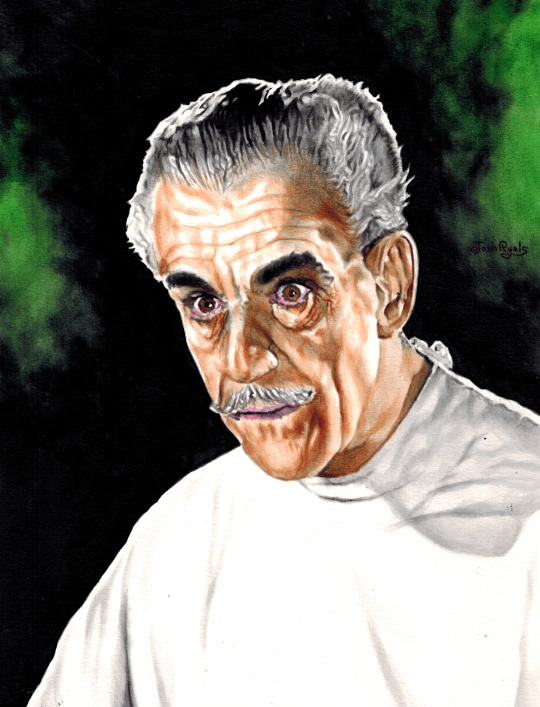
Boris Karloff as Dr. Gustav Niemann in House Of Frankenstein
Watercolors on Paper, 8.5" x 11", 2024
By Josh Ryals
#boris karloff#william henry pratt#house of frankenstein#house of frankenstein 1944#curt siodmak#erle c. kenton#jack pierce#universal classic monsters#dr. niemann#dr. gustav niemann#doctor gustav niemann#fan art#original art#portrait#painting#watercolors#mad scientists#40s horror#josh ryals#joshua ryals#josh ryals art#joshua ryals art#joshryalsart
9 notes
·
View notes
Text


#boris karloff#as#dr. gustav niemann#in#house of frankenstein#1944#fan art#original art#portrait#painting#watercolors#progress pic
4 notes
·
View notes
Note
So will any universal monsters be an overtakers?
In a manner of speaking! I've been planning on HIM joining the crew ever since I saw Renfield:

And he is intended to be in the same continuity as the classic Bela Lugosi Dracula from whom I will also be drawing inspiration:

From there, it's more up in the air.
I do kind of want to have Dracula go back for Frankenstein's Monster to follow up on his scheme from Abbott and Costello Meet Frankenstein:

And I'm quite fond of both Dr. Septimus Pretorius from Bride of Frankenstein and Dr. Gustav Niemann from House of Frankenstein
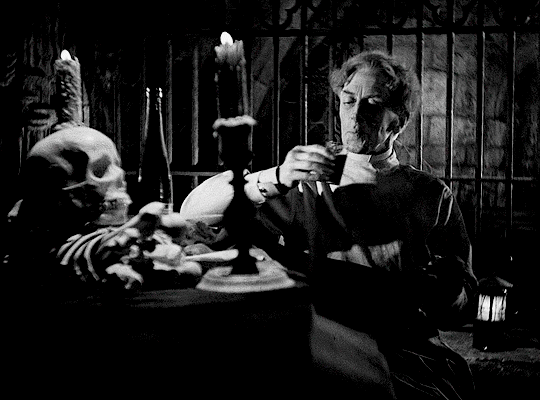

And I kind of ship them. So I might want them to come along as well.
But all of those besides Dracula are very up in the air and subject to change. These are just the ideas floating around in my head rn. I'd like to do something with the Wolf Man, but he's too much of an anti-hero for the Overtakers. Maybe have him get rescued by the heroes? Or maybe something from one of his movies can come into play?
12 notes
·
View notes
Text
This Saturday on Svengoolie (May 11, 2024): HOUSE OF FRANKENSTEIN (1944)
House of Frankenstein is a 1944 American horror film starring Boris Karloff, Lon Chaney Jr. and John Carradine. Based on a story by Curt Siodmak, it was directed by Erle C. Kenton and produced by Universal Pictures. Based on Curt Siodmak’s story The Devil’s Brood, the film is about Dr. Gustav Niemann, who escapes from prison and promises to create a new body for his assistant Daniel. Over the…

View On WordPress
0 notes
Photo
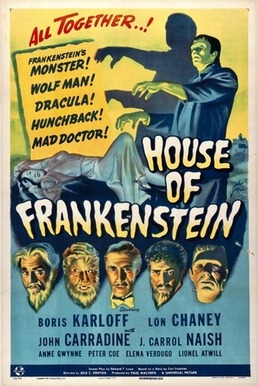
House Of Frankenstein (1944)
House of Frankenstein is a 1944 American horror film starring Boris Karloff, Lon Chaney Jr. and John Carradine. The film was directed by Erle C. Kenton based on a story by Curt Siodmak, and produced by Universal Pictures. The film is about Dr. Gustav Niemann who escapes from prison and promises to create a new body for his assistant Daniel. The two murder Professor Lampini and take over his sideshow that involves the corpse of Count Dracula. After disposing of the Count, the two move on to the ruins of Castle Frankenstein where they find the body of Frankenstein's monster and Larry Talbot, the Wolf Man preserved in the castle. Niemann thaws them and promises to cure Talbot of his werewolf curse, but secretly plots to revive Frankenstein's monster instead.
The film began production with the intention to write a story involving several Universal's horror properties. Universal had initially planned a film titled Chamber of Horrors to include several other of their horror-themed characters, but this project was halted with the idea later revived as House of Frankenstein. Filming began on April 4, 1944 and concluded on May 8. It was shown in New York on December 15, 1944.
0 notes
Photo
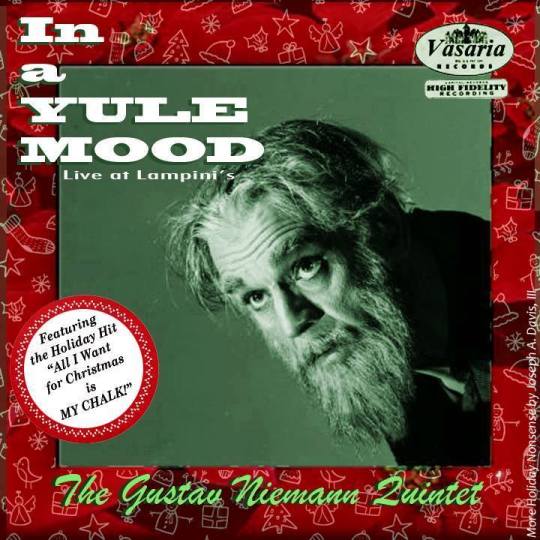
It’s December 21st (and the first day of Winter), so it’s time for another page from my annual “Advent” calendar of sorts. This is Number 21 in a series of bits of holiday nonsense that I’ve put together over the years.
#boris karloff#gustav niemann#dr. niemann#house of frankenstein#professor lampini#vasaria#christmas album parody
3 notes
·
View notes
Text
Blu-ray Review: Universal Classic Monsters: Complete 30-Film Collection

Dracula. Frankenstein’s monster and its Bride. The Wolf Man. The Mummy. The Invisible Man. Creature from the Black Lagoon. The Phantom of the Opera. You don’t have to be a horror fanatic to know these beloved monsters by name. For nearly a century, the cinematic icons have been bringing frights, chills, and joy to viewers of all ages.
Universal has collected all 30 of its classic monster movies in one extraordinary Blu-ray box set, appropriately dubbed Universal Classic Monsters: Complete 30-Film Collection. The first film in each respective franchise has been available on Blu-ray before, and the same 30-film box set was released on DVD back in 2014, but this marks the first time viewers can experience the entire collection - sequels, crossovers, and all - in high-definition.
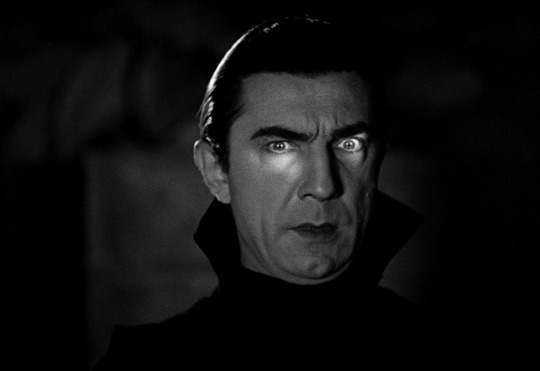
In addition to the complete box set, the movies are also available in smaller sets divided by monster, so there’s some overlap among the collection. House of Frankenstein, for example, can be found in the Dracula, Frankenstein and Wolf Man sets, since all three monsters are featured. In addition to each of the sequels, the set includes the three Abbott and Costello films in which they meet the monsters, which are an absolute hoot.
The collection kicks off with Tod Browning's 1931 adaptation of Bram Stoker’s Dracula, which stars Bela Lugosi as the unforgettable Count. 1936's Dracula's Daughter is a direct sequel with Gloria Holden as the titular progeny. It picks up immediately following the events of Dracula, but Edward Van Sloan (as Van Helsing) is the only returning cast member. 1943's Son of Dracula stars Lon Chaney, Jr. as Count Alucard. It's notable for being the first film to show a vampire is transforming into a bat on screen. Dracula would be portrayed by John Carradine in the crossover films, 1944's House of Frankenstein and 1945's House of Dracula. Lugosi would only reprise the role that made him a household name in 1948's Abbott and Costello Meet Frankenstein.
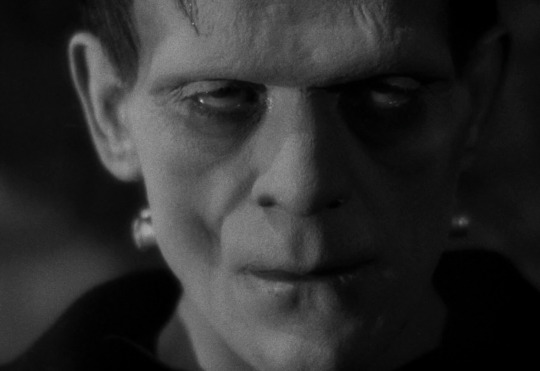
In addition to six bloodsucking films, the Dracula portion of the box set offers the most substantial bonus features. Most notably, the 1931 Spanish version of Dracula - which was shot at night using the same sets that were being used by day for the Lugosi film - is included, along with an optional introduction by actress Lupita Tovar. This rendition is a bit slow-moving, and Lugosi is missed, but it’s a great alternative to the classic that, in some ways, is superior. On the same disc is Universal Horror, a feature-length documentary from 1998 about the studio’s remarkable reign of terror, among other extras.
Frankenstein gives you the best bang for your buck. Not only is the tragic character arguably Universal’s most interesting monster, but he appears in a whopping eight films. James Whale's original 1931 Frankenstein - based on Mary Shelley's influential novel - and his 1935 follow up, The Bride of Frankenstein, are among the best one-two punches in cinematic history. Boris Karloff would play the hulking creature three consecutive times, culminating with 1939's Son of Frankenstein, before relinquishing the role to Lon Chaney Jr. in 1942's The Ghost of Frankenstein and to Bela Lugosi in 1943's Frankenstein Meets the Wolf Man. Glenn Strange played Frankenstein's monster in 1944's House of Frankenstein (which features Karloff in a new part as Dr. Gustav Niemann), 1945's House of Dracula, and 1948's Abbott and Costello Meet Frankenstein.
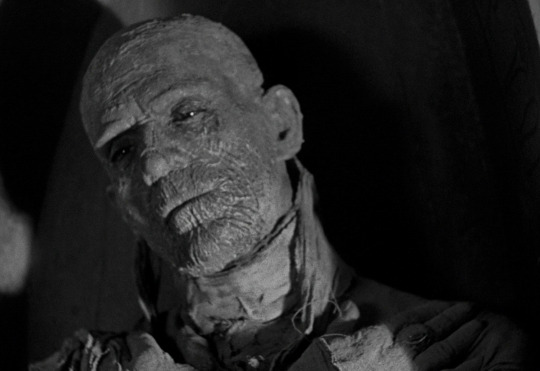
A year after Frankenstein, Karloff returned to Universal to star in 1932's The Mummy as the ancient, mummified Egyptian priest Imhotep. Rather than a direct follow-up, the concept was essentially remade as The Mummy’s Hand in 1940. This time around, Tom Tyler played the mummy, who was renamed Kharis. Lon Chaney Jr. took over the role for 1942's The Mummy's Tomb, 1944's The Mummy's Ghost, and 1944's The Mummy's Curse. Eddie Parker got under the wraps for 1955's Abbott and Costello Meet the Mummy.
In between Frankenstein and Bride of Frankenstein, director James Whale found himself at the helm of another Universal monster movie: 1933’s adaptation of H.G. Wells' The Invisible Man. Although Claude Rains’ character of Dr. Jack Griffin becomes a cold-blooded killer, the film stands out for its sense of humor, along with the groundbreaking visual effects that remain impressive. Its first sequel, 1940's The Invisible Man Returns, boasts Vincent Price in the lead role. The Invisible Woman, also released in 1940, is a full-blown screwball comedy starring Virginia Bruce. 1942's Invisible Agent and 1944's The Invisible Man's Revenge star Jon Hall as the grandson of the original character. 1951's Abbott and Costello Meet the Invisible Man features Arthur Franz as the science experiment gone wrong.

The Wolf Man is the role that brought Lon Chaney Jr. out of his illustrious father’s shadow, and it's also the only monster to be portrayed by the same actor in every film in which it appeared: the 1941 original, 1943's Frankenstein Meets the Wolf Man, 1944's House of Frankenstein, 1945's House of Dracula, and 1948's Abbott and Costello Meet Frankenstein. (Impressively, Chaney Jr. also played Dracula, Frankenstein, and The Mummy in other Universal sequels.) In addition to the five the Wolf Man movies, two other vintage tales of lycanthropy from the Universal catalog are included: 1935’s Werewolf of London and 1946’s She-Wolf of London.
Although produced by Universal, the classic 1925 silent version of The Phantom of the Opera is sadly absent from the set. The film is in the public domain, so cheap versions are easy to come by, but a high-quality copy is rare. It’s a missed opportunity, especially considering Phantom is the only monster in the box set to feature only one movie. It’s the 1943 Technicolor production starring Claude Rains that is included. This take on Gaston Leroux’s novel pales in comparison to the previous adaption, but it remains a strong picture - shot on the same set as the original, no less. The climactic reveal of the monster offers rather impressive makeup effects for its time, and the vibrant colors really pop in high definition.
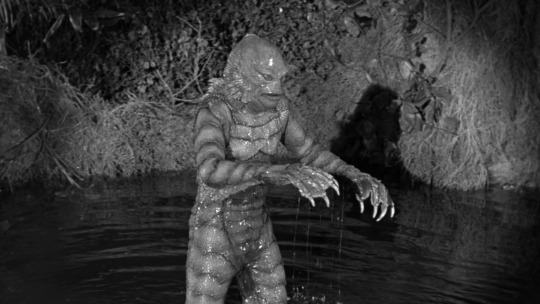
The last of the classic Universal monster movies, 1954’s Creature from the Black Lagoon, has always been a personal favorite. Although the movie itself may not be as strong as some of its precursors, Gill-man - the half-man/half-fish monster played by Ben Chapman (on land) and Ricou Browning (underwater) - is an undeniably cool character. Unlike most of the Universal classics, which were rich in Gothic atmosphere, Creature’s plot still feels contemporary. Gill-man is transplanted from the Amazon to civilization in America in its two sequels: 1955's Revenge of the Creature and 1956's The Creature Walks Among Us.
Creature from the Black Lagoon has the distinction of being the first 3D film to be shot underwater. Universal went above and beyond by including the 3D versions of the original Creature and Revenge of the Creature. (The third installment was not made for 3D.) A far cry from the crummy, old red-and-blue glasses, these have been upgraded to modern 3D technology - but you'll need a 3D TV and Blu-ray player to watch them. 2D versions are also included. (There was initially a manufacturing error with the 3D version of Revenge, but Universal swiftly implemented a replacement disc program, and the issue should be resolved on new copies.)

Each subset of the collection offers special features centering on the legacy of its respective monster and more. Several informative documentaries and audio commentaries are present as well. There aren't any new extras, but it's helpful to have everything in one convenient place alongside all of the films. The box set is rounded out by a 48-page booklet that provides context about each of the monsters and the talented people who brought them to life, accompanied by vintage ads and images.
Universal Classic Monsters: Complete 30-Film Collection is a must-own release for any horror fan. Several of the films are, remarkably, more than 80 years old, but they still hold up, with the high-definition transfers giving them new life. Some have fared better than others over the years, but even the lesser entries remain fun. With runtimes averaging around 75 minutes, each picture is an easily digestible slice of spooky entertainment; a perfect way to set the mood during the Halloween season. With Universal's “Dark Universe” failing to take off after The Mummy, the studio execs ought to revisit these timeless classics before attempting the inevitable next reboot.
Universal Classic Monsters: Complete 30-Film Collection is available now on Blu-ray and DVD via Universal.
#dracula#frankenstein#creature from the black lagoon#phantom of the opera#the wolf man#bride of frankenstein#the invisible man#review#dvd#the bride of frankenstein#article#gift#the phantom of the opera#the creature from the black lagoon#wolf man#invisible man#universal monsters
47 notes
·
View notes
Quote
Daniel: Could Frankenstein have made me like other men?
Dr. Gustav Niemann: He gave life to a body that he made from parts of other bodies that had died. Yes, Daniel, he could have made you like other men.
Curt Siodmak, The House of Frankenstein, December 15, 1944.
6 notes
·
View notes
Photo
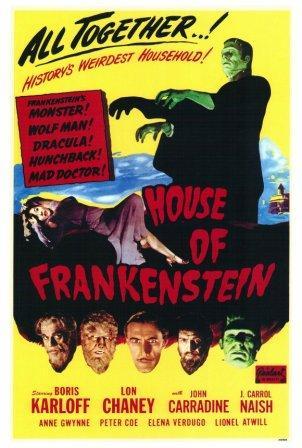
New Post has been published on http://www.classicfilmfreak.com/2017/07/13/the-house-of-frankenstein-1944-starring-boris-karloff-lon-chaney-jr-and-john-carradine/
The House of Frankenstein (1944) starring Boris Karloff, Lon Chaney, Jr. and John Carradine
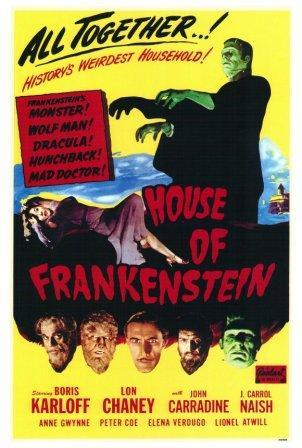
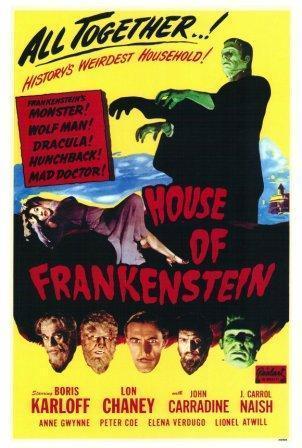
“As for you Strauss, I’m going to give you the brain of the wolf man so that all your waking hours will be spent in untold agony awaiting the full of the moon . . . which will change you into a werewolf.”—— Dr. Niemann (Karloff)
It is hard to tell with Universal Pictures, difficult to keep track of the myriad, seemingly endless horror films, especially during the 1930s and ’40s, at least one film a year.
The studio’s best sound films came in the ’30s, beginning with Dracula and Frankenstein, both in 1931. Then followed The Old Dark House and The Mummy, the best two releases of that bumper crop year, 1932, which included at least four exceptional horror productions. The Invisible Man, with its then amazing special effects, appeared in 1933. The decade peaked in 1935 with The Bride of Frankenstein, not only a great horror film, but a great, milestone film, period. And, to close the ’30s, Son of Frankenstein in 1939.
Although the horror film was still in vogue, the ’40s brought a discernible decline, both in the number of releases and, more crucially, in the quality of the films. While interesting in its own right, The Invisible Man Returns (1940) was a pale sequel after its Claude Rains predecessor. A high point, though, was The Wolf Man (1941), recalling the glories of the ’30s, and Lon Chaney, Jr.’s first stint as the tormented man-turned-werewolf, for, yes, “even a man who’s pure in heart and says his prayers at night . . . ”

Universal’s frequent turn to horror comedies had been highly successful in 1939 with Bob Hope’s The Cat and the Canary, and continued into the ’40s with The Invisible Woman (1940) and Hold That Ghost (1941), the first in the horror genre by comedy team Bud Abbott and Lou Costello.
There also emerged a trend, sometimes tepidly executed, toward the serious and the non-monster movie, more adult fare. The Uninvited (1944) featured a mere filament of a floating ghost, which was dispatched with some stern words from non-horror star Ray Milland. Another remake of The Phantom of the Opera (1943), now in color, starred Rains who wreaked havoc on an opera house. And The Unseen (1945), an early take on the serial killer, showcased a human monster, with still more non-horror stars, Joel McCrea and Gail Russell.
In the 1950s Universal had abandoned Dracula, the Frankenstein monster, the werewolf and the Mummy. In their places, from Universal and other studios, now came aliens from outer space and insects and cephalopods giganticized by radiation from man’s mishandling of things beyond his understanding. But this is entirely another offspring of the horror film, for discussion at another time.
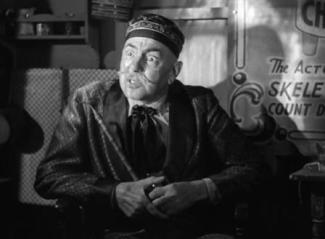
Returning to the ’40s, by the time of The House of Frankenstein—the gang’s all here in this one except the Mummy!—the Dracula-Frankenstein-Wolf Man movies had so overlapped, intermingled and been repeatedly rehashed that little, if anything, new remained to say—or show.
This, however, didn’t prevent production on House, and for the possible few in the audience who might be unfamiliar with the stories, lectures were deemed necessary. George Zucco, in his brief screen time, explains, as if anew, the Dracula legend, and Boris Karloff informs new viewers and reminds the old ones about the Frankenstein monster’s origins and social interaction problems. It could be assumed that if someone is so inclined to watch House, he would have seen the earlier films and been familiar with it all.
If there were any ways for these plots and stories to be reinvigorated, or at least done with a new approach, Universal didn’t use them. House is, in fact, two movies. The first—and better—half is about Dracula and the Frankenstein monster; the second half concerns another of poor, distressed Larry Talbot’s search for a cure for his hypertrichosis, this serious wolf transmutation.
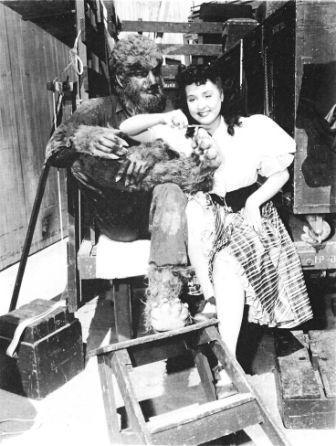
Compared with most of the scores in these films, Hans J. Salter, now aided by an uncredited Paul Dessau, produces a less horror-sounding main title. Eliminated, too, is that camera roaming the traditional fog-drenched woods, most memorable in The Wolf Man, now replaced by a matte of a non-threatening blur, which seems to complement the more lyrical moments of this particular main title.
Even before the fading of the final credit, “Directed by Erle C. Kenton,” the film has already begun. A team of four horses is pulling a two-wagon caravan through a rainy night. As the first wagon passes in a close-up—the distorted reflection of studio lights clearly visible on its smooth surface—painted on the side is “Professor Lampini’s Chamber of Horrors.”
The caravan, to be seen later, passes by the gates of Neustadt Prison, where, inside, a guard (Charles Wagenheim), accompanied by lumbering bassoons, is bringing food to one of the prisoners. When the guard opens the small window of the cell door, an arm reaches out and grabs him in a choking hold. “Now will you give me the chalk?” Just like this man to demand chalk when a common criminal would have insisted on the keys to his cell!
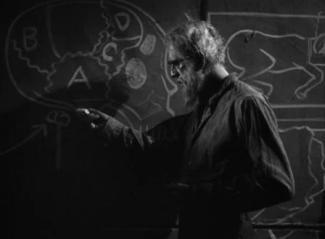
Now with his chalk and blackboards, Doctor Gustav Niemann (Karloff) illustrates how Dr. Frankenstein might have gone wrong in severing the monster’s spinal cord at the base of the skull. In an adjoining cell, his one student, so to speak, is hunchback Daniel (J. Carrol Naish), a low-key hysteric (if such is possible) who will soon be humbly calling Niemann “master” and be all too willing to do his bidding.
Niemann’s objective, as he tells Daniel, is to retrieve Dr. Frankenstein’s records from his castle which, keen viewers will remember, was flooded at the end of Frankenstein Meets the Wolf Man (1943), drowning both the monster and the Wolf Man.
Fate, with a little help from the screenplay, generates a timely storm and lightning brings down part of the prison. Niemann and Daniel escape through the woods, only to come upon Lampini’s caravan, stuck in the mud. What a coincidence! With the escapees’ help, Professor Lampini (Zucco) frees the wagons. When Lampini says he has no intention of going to Reigelberg, not to Vasaria where Niemann is headed, the doctor has Daniel kill the showman.
As the caravan rattles toward Reigelberg—all the carriages in Sir Arthur Conan Doyle’s Sherlock Holmes stories “rattle”—Niemann assumes Lampini’s identity, telling Daniel, “All the protection of a traveling show . . . free to move on to those for whom I have unloving memories . . . ” He has several scores to settle with old enemies, including the bürgemeister of Reigelberg, Hussman (Sig Ruman, best remembered as the barracks guard in Billy Wilder’s Stalag 17, 1953).

An effective screen dissolve and Hussman is playing chess with Police Inspector Arnz (a rather tame part this time around for horror staple Lionel Atwill). Enter the bürgemeister’s son Karl (Peter Coe) and his American wife Rita (Anne Gwynne). She invites them to a visiting show of horrors. “Spooks, ghouls, vampires,” she jokes.
Apparently it is during Niemann’s first show that things turn uncomfortable. About the time Hussman is thinking Niemann looks familiar, the mad doctor shows the audience Dracula’s skeleton, snug in its coffin, and boasts, “If I were to remove this stake . . . ”
Perhaps doubting the power of the Dracula curse, or because of a mental lapse, Niemann does absentmindedly remove the stake from between the skeleton’s ribs, lifting it toward Hussman. But, then, he’s distracted. In the first of Universal’s (John P. Fulton’s) special effects in the film, the skeleton materializes into the corporeal Dracula (John Carradine). Dracula agrees to serve Niemann when the doctor threatens to reinsert the stake: “I’ll send your soul back to the limbo of eternal waiting.”

After Dracula has seduced Rita, enticing her with his finger ringer that sends her into a mesmeric trance, seeing people “who are dead yet alive,” Niemann destroys Dracula’s coffin and its nighttime occupant perishes in the sunlight. End of the so-called “first movie.”
Now, onward, to Frankenstein’s castle with all haste! And surprise! Niemann and Daniel find, without much trouble, the bodies of the monster (Glenn Strange) and the Wolf Man (Chaney), frozen in the waters, though, strange, the surrounding climate is warm enough for shortsleeves! (No, no—such incongruities aren’t questioned in horror films and the most faithful devotees of the genre take all these in stride.)
Niemann thaws the two bodies, again without much trouble, and promises to cure the Wolf Man of his full moon hang-up. Meanwhile, Daniel has taken a fancy to gypsy girl Ilonka (Elena Verdugo), whose mind seems numb to the unsavory hunchback. She is more interested in Talbot, and numb, again, now to this guy’s own problem. Anyway, Talbot kills Ilonka during a werewolf spell, but she kills him with a silver bullet before she dies.

Will those who are left be disposed of as well? Niemann has dragged his feet in his promise to restore Daniel’s deformed body, and now Daniel believes his master is responsible for Ilonka’s fate and turns on him. But the monster throws him out the window, and carries the half-conscious Niemann through the woods, pursued by the angry villagers, the familiar torches at the ready.
In restoring the monster to life, Niemann apparently neglected to improve its mental capacities, for when the good doctor warns this giant, “Don’t go this way. Quicksand! Quicksand!,” the monster heeds not a word, and——
Not to worry. Next year, 1945, the Frankenstein monster, Dracula and the Wolf Man will have a whole new beginning, another rebirth, in The House of Dracula, all creatures played by the same actors from House of Frankenstein.
https://www.youtube.com/watch?v=6Wp50RXhyRo
0 notes